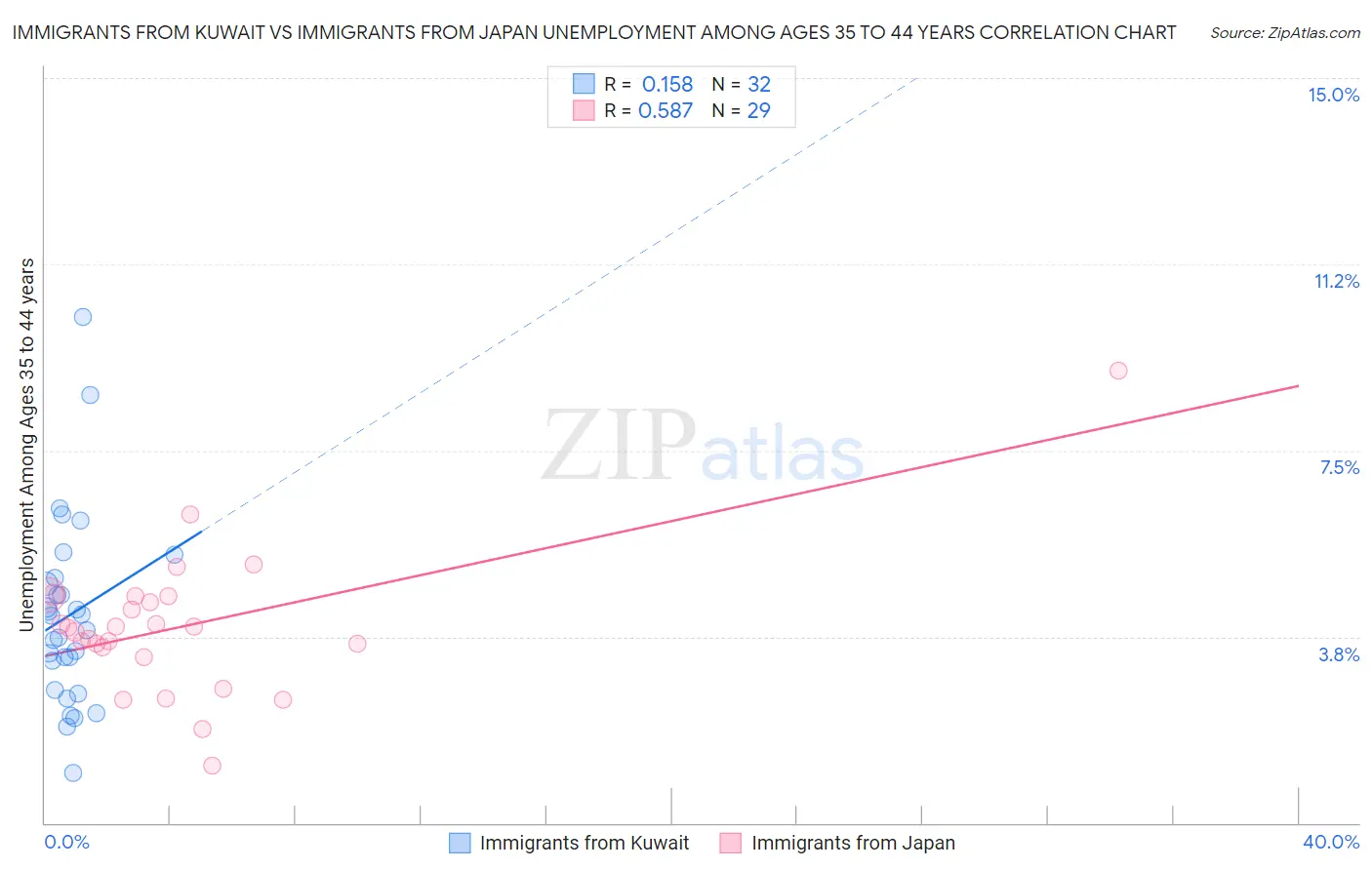Immigrants from Kuwait vs Immigrants from Japan Unemployment Among Ages 35 to 44 years
COMPARE
Immigrants from Kuwait
Immigrants from Japan
Unemployment Among Ages 35 to 44 years
Unemployment Among Ages 35 to 44 years Comparison
Immigrants from Kuwait
Immigrants from Japan
4.3%
UNEMPLOYMENT AMONG AGES 35 TO 44 YEARS
99.5/ 100
METRIC RATING
23rd/ 347
METRIC RANK
4.3%
UNEMPLOYMENT AMONG AGES 35 TO 44 YEARS
99.3/ 100
METRIC RATING
28th/ 347
METRIC RANK
Immigrants from Kuwait vs Immigrants from Japan Unemployment Among Ages 35 to 44 years Correlation Chart
The statistical analysis conducted on geographies consisting of 136,247,564 people shows a poor positive correlation between the proportion of Immigrants from Kuwait and unemployment rate among population between the ages 35 and 44 in the United States with a correlation coefficient (R) of 0.158 and weighted average of 4.3%. Similarly, the statistical analysis conducted on geographies consisting of 334,262,048 people shows a substantial positive correlation between the proportion of Immigrants from Japan and unemployment rate among population between the ages 35 and 44 in the United States with a correlation coefficient (R) of 0.587 and weighted average of 4.3%, a difference of 0.63%.

Unemployment Among Ages 35 to 44 years Correlation Summary
| Measurement | Immigrants from Kuwait | Immigrants from Japan |
| Minimum | 1.0% | 1.2% |
| Maximum | 10.2% | 9.1% |
| Range | 9.2% | 7.9% |
| Mean | 4.2% | 4.0% |
| Median | 4.0% | 3.9% |
| Interquartile 25% (IQ1) | 3.0% | 3.4% |
| Interquartile 75% (IQ3) | 4.9% | 4.6% |
| Interquartile Range (IQR) | 1.9% | 1.1% |
| Standard Deviation (Sample) | 1.9% | 1.4% |
| Standard Deviation (Population) | 1.9% | 1.4% |
Demographics Similar to Immigrants from Kuwait and Immigrants from Japan by Unemployment Among Ages 35 to 44 years
In terms of unemployment among ages 35 to 44 years, the demographic groups most similar to Immigrants from Kuwait are Tlingit-Haida (4.3%, a difference of 0.010%), Scandinavian (4.2%, a difference of 0.15%), Paraguayan (4.2%, a difference of 0.41%), Bulgarian (4.3%, a difference of 0.48%), and Turkish (4.3%, a difference of 0.54%). Similarly, the demographic groups most similar to Immigrants from Japan are Assyrian/Chaldean/Syriac (4.3%, a difference of 0.080%), Turkish (4.3%, a difference of 0.090%), Bulgarian (4.3%, a difference of 0.15%), European (4.3%, a difference of 0.20%), and Immigrants from Pakistan (4.3%, a difference of 0.26%).
| Demographics | Rating | Rank | Unemployment Among Ages 35 to 44 years |
| Tongans | 99.8 /100 | #15 | Exceptional 4.2% |
| Cubans | 99.8 /100 | #16 | Exceptional 4.2% |
| Swedes | 99.8 /100 | #17 | Exceptional 4.2% |
| Latvians | 99.8 /100 | #18 | Exceptional 4.2% |
| Immigrants | Nepal | 99.7 /100 | #19 | Exceptional 4.2% |
| Immigrants | Bolivia | 99.7 /100 | #20 | Exceptional 4.2% |
| Paraguayans | 99.6 /100 | #21 | Exceptional 4.2% |
| Scandinavians | 99.5 /100 | #22 | Exceptional 4.2% |
| Immigrants | Kuwait | 99.5 /100 | #23 | Exceptional 4.3% |
| Tlingit-Haida | 99.5 /100 | #24 | Exceptional 4.3% |
| Bulgarians | 99.3 /100 | #25 | Exceptional 4.3% |
| Turks | 99.3 /100 | #26 | Exceptional 4.3% |
| Assyrians/Chaldeans/Syriacs | 99.3 /100 | #27 | Exceptional 4.3% |
| Immigrants | Japan | 99.3 /100 | #28 | Exceptional 4.3% |
| Europeans | 99.2 /100 | #29 | Exceptional 4.3% |
| Immigrants | Pakistan | 99.2 /100 | #30 | Exceptional 4.3% |
| Carpatho Rusyns | 99.2 /100 | #31 | Exceptional 4.3% |
| Chinese | 99.1 /100 | #32 | Exceptional 4.3% |
| Immigrants | Sri Lanka | 99.1 /100 | #33 | Exceptional 4.3% |
| Jordanians | 99.0 /100 | #34 | Exceptional 4.3% |
| Luxembourgers | 99.0 /100 | #35 | Exceptional 4.3% |